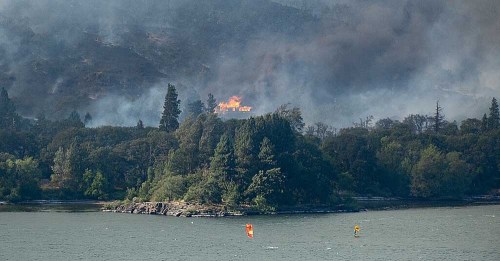Investigation finds BNSF railway at fault for Washington’s Tunnel 5 Fire
Published 7:45 pm Thursday, September 14, 2023

- A hilltop house burns above Columbia River during the Tunnel 5 Fire in July 2023.
SKAMANIA COUNTY, Wash. — On July 2, just east of Burlington Northern Santa Fe Tunnel 5 in Skamania County, Washingon, a blaze eventually designated as the Tunnel 5 Fire was ignited.
Burning adjacent to heavily traveled Washington State Route 14 in the Columbia River Gorge National Scenic Area, the fire consumed more than 500 acres and destroyed 10 structures, most of them private residences.
Now a State of Washington Department of Natural Resources wildland fire investigation report obtained by Columbia Insight has pinpointed debris from brakes and carbon emission particles from a BNSF locomotive engine as the cause of the blaze.
According to the report, a BNSF train traveled through the origin area of the Tunnel 5 fire at approximately 10:53-11 a.m. July 2 and “emitted some object(s)” that started fire in three areas over a roughly 690-foot distance, all on the north side of the tracks and east of Tunnel 5.
“No probable evidence of another Human fire cause was located in the origin areas,” according to the 22-page report.
The report includes photographs taken by onlookers, surveillance video, witness testimony and interviews with BNSF officials.
“After eliminating other probable causes for this fire, the Wildland Fire Investigation determined this fire was started by Human means: Railroad Operations; Right of Way Vegetation Maintenance; Wheel Lubrication Parts; and Exhaust Particles,” the report concludes.
DNR approved the report on Aug. 25.
According to the InciWeb page, the Tunnel 5 Fire still is under investigation. InciWeb is a multi-governmental, interagency all-risk incident information management system.
Older engine may be to blame
One of the the more compelling sections of the report focuses on testimony from a pair of train enthusiasts, a man and his son, who happened to be photographing trains moving through the Gorge on the morning of the fire.
“They spotted an old BNSF green and white locomotive leader engine with a newer orange and black engine behind it. The older lead engine had the number 2322 on it, and the newer orange and black engine had the number 2600. These engines were pulling 12-15 loaded cars which appeared to have lumber on them. This train was WB (westbound) from White Salmon, going toward Vancouver, WA,” reads the report.
According to the man interviewed, who happens to be a railroad employee, the green and white engine (2322) was possibly more than 40 years old and was likely non-turbocharged.
“In his experience with Union Pacific (UP) this green and white engine is not commonly used on open tracks in the Columbia River Gorge area,” reads the DNR report. “Being a non-turbocharged engine, it has a high likelihood of emitting diesel carbon emissions from the exhaust which could start a fire. (The man) added that it was UP practice to not use these older non-turbocharged engines in the Columbia Gorge during summer months due to their propensity to start fires. UP primarily used these older engines within train yards/depots, and not out on open tracks in summer months.”
While conducting an on-the-ground inspection after the fire, the lead DNR investigator “noticed a lot of what appeared to be metallic pieces of varying size, many of which had sheared off or had sharply cut fine shiny edges.
“I later learned from the BNSF that these shiny metallic looking pieces were a solid polymer lubricating pad which rubs against the moving train wheels and is manufactured by MPLTECHNOLOGY.com. I collected a total of 72 solid polymer pads and 2 possible carbon emission particles.”
Smaller railroad fires just days before
The DNR report includes photographs and testimony from numerous witnesses who called 911 within minutes of the start of the blaze.
The report digs deeper into railroad operations in the general and specific areas of where DNR says the fire began. And it identifies other fires started by the railroad in the same area in the week leading up the Tunnel 5 blaze.
“Additionally, BNSF track maintenance activities had ignited two other fires in the same vicinity just 5 and 8 days earlier. These two track maintenance fires occurred during hours of darkness when temperatures would have been cooler and humidity higher. A localized fire danger along the tracks in this general area should have been known to BNSF,” reads the report.
DNR says its Tunnel 5 Fire report is preliminary.
In 2007, the Broughton Fire burned 200 acres and seven structures (including five houses) in the precise location as the Tunnel 5 Fire.
That fire was determined to have been caused by the BNSF Railway Co.’s grinding of nearby railroad tracks.
”Track grinding” or “rail grinding” repairs deformities and corrosion of rail tracks due to heavy use. The process creates sparks that can lead to fires, especially in the dry brush that lines the tracks in summer.





